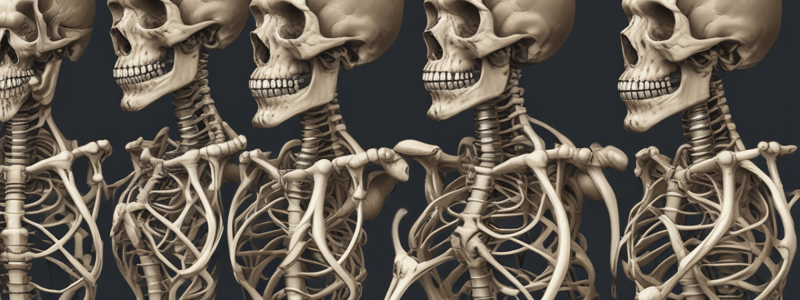Podcast
Questions and Answers
What is the primary difference between fibrous and cartilaginous joints?
What is the primary difference between fibrous and cartilaginous joints?
Fibrous joints are held together by dense regular connective tissue and do not have a joint cavity, while cartilaginous joints are joined by cartilage and also lack a joint cavity.
How does the presence of a joint cavity in synovial joints enhance mobility?
How does the presence of a joint cavity in synovial joints enhance mobility?
The joint cavity in synovial joints allows for greater range of motion by providing fluid lubrication, which reduces friction between articulating surfaces.
What role do ligaments play in synovial joints?
What role do ligaments play in synovial joints?
Ligaments attach bones to each other within synovial joints, providing stability while allowing for mobility.
What is arthrology and why is it significant in the study of joints?
What is arthrology and why is it significant in the study of joints?
Explain the inverse relationship between mobility and stability in joints.
Explain the inverse relationship between mobility and stability in joints.
Why is it important to categorize joints both structurally and functionally?
Why is it important to categorize joints both structurally and functionally?
What type of joint is classified as synarthrosis and what are its main characteristics?
What type of joint is classified as synarthrosis and what are its main characteristics?
How does the structure of a synovial joint contribute to its classification as diarthrosis?
How does the structure of a synovial joint contribute to its classification as diarthrosis?
What is the inverse relationship between mobility and stability in joints?
What is the inverse relationship between mobility and stability in joints?
What characterizes cartilaginous joints, and how are they categorized functionally?
What characterizes cartilaginous joints, and how are they categorized functionally?
Can all amphiarthroses be classified as fibrous joints? Justify your answer.
Can all amphiarthroses be classified as fibrous joints? Justify your answer.
Describe the role of synovial fluid in diarthrosis joints.
Describe the role of synovial fluid in diarthrosis joints.
What is the significance of the articular capsule in synovial joints?
What is the significance of the articular capsule in synovial joints?
In the context of joint classifications, how would you differentiate between a hinge joint and a ball-and-socket joint?
In the context of joint classifications, how would you differentiate between a hinge joint and a ball-and-socket joint?
Explain why a suture is classified as a synarthrosis.
Explain why a suture is classified as a synarthrosis.
What defines the structural characteristic of fibrous joints, and how does this impact their functionality?
What defines the structural characteristic of fibrous joints, and how does this impact their functionality?
Flashcards are hidden until you start studying
Study Notes
Joint Classification
- A joint is the place of contact between bones, between bone and cartilage, or between bones and teeth.
- Joints are classified by both structural and functional characteristics.
Structural Classification
- Fibrous Joints:
- Have no joint cavity
- Bones are held together by dense regular connective tissue
- Examples: Gomphosis, Suture, Syndesmosis
- Cartilaginous Joints:
- Have no joint cavity
- Bones are joined by cartilage
- Examples: Synchondrosis, Symphysis
- Synovial Joints:
- Have a joint cavity filled with lubricating fluid
- Articulating surfaces are enclosed within a connective tissue capsule
- Attached to each other by various ligaments
- Examples: Plane, Hinge, Pivot, Condylar, Saddle, Ball-and-socket joints
Functional Classification
- Synarthrosis:
- Immobile joints
- Two types of fibrous joints and one type of cartilaginous joint are synarthroses
- Amphiarthrosis:
- Slightly mobile joints
- One type of fibrous joint and one type of cartilaginous joint are amphiarthroses
- Diarthrosis:
- Freely mobile joints
- All synovial joints are diarthroses
Mobility and Stability
- There is an inverse relationship between mobility and stability in articulations
- The more mobile a joint, the less stable it is, and vice versa
- If a joint is immobile, it has maximum stability
Studying That Suits You
Use AI to generate personalized quizzes and flashcards to suit your learning preferences.




